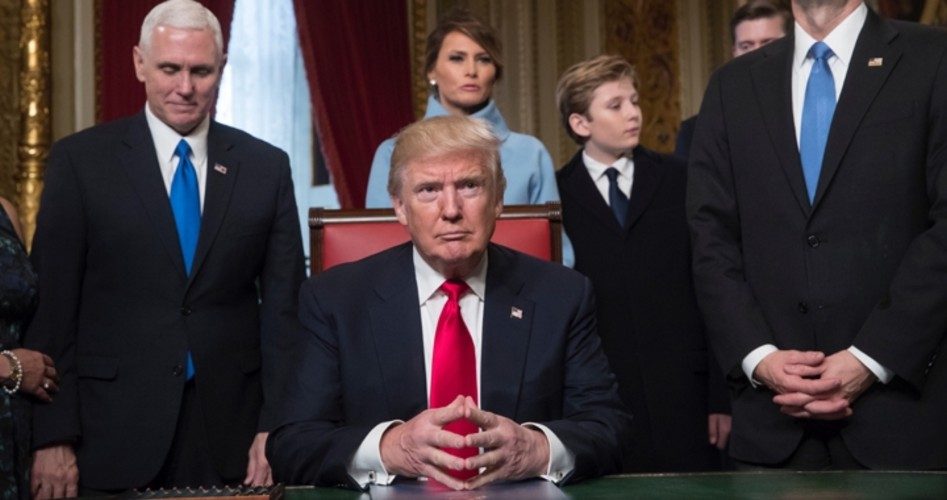
“I have a pen and a phone,” then-President Barack Obama said during his presidency, promising to change federal government policy via executive actions if Congress did not enact certain laws he was demanding. Likewise, the new president, Donald Trump, is expected to use the same method to overturn some of those actions — in areas such as immigration and climate change.
Trump spokesman Sean Spicer even suggested he would take action on four or five issues as early as his first day on Friday, some on Saturday, and more early this week. In all, Spicer predicted that Trump could reverse as many as 200 in the first week. With the traditional parade on Friday afternoon, followed by some Inaugural Balls to attend on Friday night, the new president did not have time to take too many actions the very first day.
“He’s got a few of them probably in the area of four or five that we’re looking at for Friday,” Spicer had said on Inauguration Day. “Then there are some other ones that I expect him to sign with respect to a couple of issues that have been high on his priority list.”
Spicer announced late in the day on Friday that Trump will order executive departments and agencies to “relieve the burdens of ObamaCare,” which he did, while the government transitions to a new healthcare system to replace the Affordable Care Act.
Trump’s executive order directed those in the executive branch to “exercise all authority and discretion available to them to waive, defer, grant exemptions from, or delay the implementation of any provision or requirement of the Act that would impose a fiscal burden on any State or a cost, fee, tax, penalty, or regulatory burden on individuals, families, healthcare providers, health insurers, patients, recipients of healthcare services, purchasers of health insurance, or makers of medical devices, products, or medications.”
Of course, Trump can only do so much as president with an executive order. Congress will need to enact legislation to deal effectively with the most important parts of ObamaCare. The law was written to give the executive branch considerable discretion in its enforcement of the legislation. Of course, this discretion, which the Democrat-controlled Congress placed in the hands of a Democrat president, is now in the hands of a Republican who has publicly condemned the law.
Hopefully, now that a Republican sits in the White House, the Republican Congress will be consistent and oppose a president who attempts to “make law” through executive orders, rather than simply using those orders to enforce the law.
Among areas that Trump is expected to address through executive orders and presidential memoranda includes so-called global climate change. It is anticipated that Trump will require all Cabinet departments to disclose all current work being done in connection with Obama administration initiatives concerning carbon emissions to supposedly combat “global climate change,” then cease that work. It was reported on Friday that the White House website immediately took down references to global warming and global climate change the moment Trump took office — at 12 noon Eastern Time Friday.
He is also expected to withdraw the United States from the 12-nation Trans-Pacific Partnership (TPP) trade deal on Monday and begin talks to change the North American Free Trade Agreement (NAFTA), a deal he often criticized during his campaign.
Another issue that was an important part of Trump’s campaign last year was immigration, and he is expected to issue an executive order to begin the construction of a wall on the U.S.-Mexican border. In addition, he will almost certainly rescind the order Obama gave late in his presidency allowing 700,000 illegal aliens who were brought into the country by parents when they were children. While he will not likely begin rounding up and deporting these individuals, he is expected to order the expiration of Obama’s order that essentially circumvented federal immigration law.
Democrats, of course, will not take this sitting down. It is likely that they will suddenly become champions of the concept of separation of powers, which they largely ignored during Obama’s term because Obama was taking actions they agreed with but were unable to pass through the Republican-controlled Congress. They can be expected to now argue that President Trump is not constitutionally able to make law through “executive orders.”
And they will be correct. According to the Constitution, in Article I, Section 1, “All legislative powers herein granted shall be vested in a Congress of the United States, which shall consist of a Senate and House of Representatives.” “All” leaves no room for a president to make law by executive order. The president has no power under the Constitution to make any laws, but his job is rather to “take care that the laws be faithfully executed.” In short, he is to put into effect laws passed by Congress, but cannot make laws on his own.
In this regard, the president certainly has the power to issue executive orders, but what this means is much misunderstood by a populace conditioned to think the president has more power than he actually is given in the Constitution. He is not a “four-year king.” For example, even many “conservative” commentators often refer to the president as “our commander-in-chief.” But the president is not commander-in-chief of the average American citizen, and has no more authority over an average citizen than any other American citizen. His title of commander-in-chief refers to his position in relationship to the armed forces of the United States.
Others flippantly refer to the election of the president as deciding who is going to “run the country.” This invites totalitarianism. The president does not “run the country,” but rather only the executive branch of the federal government.
This is where executive orders come in. The president, to carry out his constitutional duty to make sure the laws are faithfully executed, has legal authority to issue executive orders to members of the executive branch of the government to carry out the will of Congress. If he believes an act of Congress violates the Constitution, he not only has a right, but he has a duty to veto that act. After all, he took an oath to “preserve, protect, and defend the Constitution of the United States.”
Because there are executive orders that are not only allowable under the Constitution, but are in fact a constitutional duty of the president, it is rather meaningless to judge a president’s adherence to the Constitution by the number of executive orders. One executive order to make law is one too many.
In instances in which President Obama used executive orders to make laws, rather than simply carry out laws, President Trump can simply issue a new executive order to cancel them.
Obama’s 292 executive orders are actually fewer in number than those issued by either President George W. Bush or President Bill Clinton. This is, of course, a meaningless statistic. Instead, we need to look at some specific executive orders issued by Obama for which he had no actual law passed by Congress to enforce.
For example, Obama has essentially “amended” the Affordable Care Act with various executive orders. He has issued executive orders of dubious constitutionality in the areas of gun control, Syrian “refugees,” global warming, income inequality, as well as immigration.
On the other hand, a Trump executive order to begin building a wall on the Mexican border would be legitimate, regardless of what one thinks about the wisdom of such a policy. This is because Congress has already passed legislation to begin construction of a wall to keep out illegal aliens from Mexico, but Obama has failed to “take care” that that legislation be implemented. For that matter, one reason that we have the extensive immigration problem we now have is not because we don’t have laws to deal with the problem, but because recent presidents have failed to enforce present immigration laws.
Constitutionalists can hope that Trump and the Republicans will not simply continue the policy of recent presidents, including Obama, of using a “pen and a phone” in an attempt to make law. In some cases, such executive actions are relatively harmless, except that they contribute to the mistaken idea that the president is the average citizen’s “commander-in-chief,” and that he “runs the country.”
Trump has promised to enact regulatory reform to correct executive branch misconduct, and this includes the multiple federal agencies and departments. He has said he will eliminate two rules for every one enacted. That is a good start, but one unconstitutional rule promulgated via presidential executive order or through the rule-making process of some faceless bureaucrat is one too many.
The House of Representatives has passed three bills, including the REINS Act, the Regulatory Accountability Act, and the Midnight Rules Relief Act, all of which await action in the Senate. They are reforms in the right direction.
Finally, the most egregious executive action is the practice of many recent presidents of sending American military forces into foreign countries without any authorization by Congress. Constitutionally speaking, once Congress declares a state of war, then the president has legal authority to conduct the war as “commander-in-chief.” Hopefully, President Trump and the Republican Congress will address this very serious violation of the Constitution, as well. As Thomas Jefferson said, the dog of war is too serious a matter to be left to one man.
Photo: AP Images

